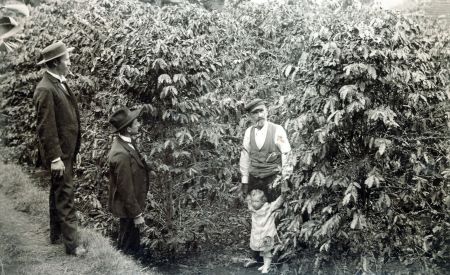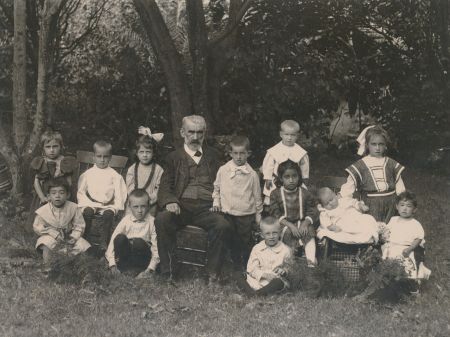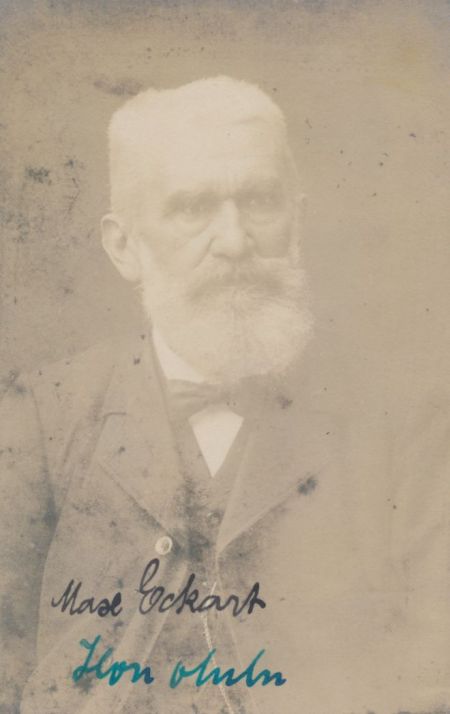Maximilian Eckart (Da VII 12)/en: Unterschied zwischen den Versionen
(Die Seite wurde neu angelegt: „====== From Honolulu to Maui ====== Datei:1910_F00344_DaVII8_Maximilian_Eckart_mit_Enkelkindern.jpg|450px|thumb|right|Maximilian already had twelve grandchil…“) |
(Die Seite wurde neu angelegt: „450px|thumb|none|One of the last pictures of Maximilian Eckart, around 1915.“) |
||
| Zeile 25: | Zeile 25: | ||
[[Datei:1915_ca_F00342_DaVII6_Maximilian_Eckart.jpg|450px|thumb|none| | [[Datei:1915_ca_F00342_DaVII6_Maximilian_Eckart.jpg|450px|thumb|none|One of the last pictures of Maximilian Eckart, around 1915.]] | ||
== Familie == | == Familie == | ||
Version vom 15. Juni 2021, 20:21 Uhr
Maximilian Eckart (Da VII 12), (*February 7, 1842, in Emskirchen, Germany; †April 18, 1918, in Wailuku, Maui, Hawaii, USA), married Maria Louisa Campbell on January 25, 1878, in Waimea, Hawaii, USA
Childhood and youth in Emskirchen
Maximilian Eckart was born on February 7, 1842, the twelfth and last child of David and Jeanette Eckart. He spent his childhood with his siblings in his parents’ inn, the "Schwarzer Adler" (Black Eagle) in Emskirchen. His father, the "jolly Eckart", and his inn were particularly popular among students, and boozy festivities were regularly held in the ballroom on the second floor; the same floor where the children also had their rooms. The children had to help in the inn and the household already from an early age. David also frequently took them hunting or to his fish breeding in the community pond. However, the family’s financial situation deteriorated. Gradually, they had to sell all their landed property and, in 1850, the inn. Maximilian was only eleven years old when his father died in 1853. From that point onwards, Jeanette had to fend for herself and her children. Ultimately, Emskirchen no longer had much to offer the adolescent Eckarts, which is why all David and Jeanette Eckart’s children gradually left their hometown between 1850 and 1870.
Jeweler and butcher
Maximilian completed an apprenticeship as a silversmith in Emskirchen but had worked as a butcher most of the time. His brother Christian, eleven years his senior, had already emigrated to Brazil in 1855 and then via San Francisco to Hawaii, where he had married and opened a jewelry store. At that time, Hawaii was not yet part of the United States, but rather an independent kingdom, reigned by King Kamehameha V. Maximilian benefitted from the connection with his brother and followed him to Honolulu in order to work there as a jeweler. Maximilian Eckart left Emskirchen at the age of 26 and reached Honolulu from San Francisco on the steamship "Idaho" in August 1868. Christian had given him money for the journey.
Hawaii – Germany and back
Maximilian quickly adapted to this new environment. He was a diligent and committed worker in his brother’s business. Whenever Christian and his wife Mathilde went on holiday, Maximilian managed the store on his own. He remained in contact with his mother by letter until her death in Emskirchen in 1874. The following year, Christian and Mathilde Eckart died. They had remained childless, which meant Maximilian was the last Eckart in Hawaii for a number of years. After having sworn allegiance to the Hawaiian kingdom on November 22, 1875, thus officially becoming a Hawaiian citizen, he took over his late brother’s business in late November. Shortly afterwards, he fell seriously ill with appendicitis. Despite his doctor having warned him that he would not survive the journey home to Germany, Maximilian boarded the steamship "Mikado" in February 1876 and embarked upon the long voyage to Germany. Amazingly, he survived the crossing and the subsequent surgery. He stayed in his home country for a while, and then returned to Hawaii in 1877. The jewelry store, which he had closed before leaving, remained closed even after his return. Maximilian visited the Hawaiian Islands instead. During this journey, he met Maria Louisa Campbell. He had worked as a butcher on her father’s ranch. In January 1878, Maximilian Eckart, who was 35 years old at the time, married the 15-year-old Maria Louisa Campbell.
Royal customers
Together, they moved back to Honolulu where Maximilian returned to the jewelry business. He produced clocks as well as classic gold and silver jewelry, but also traditional Hawaiian jewelry made from kukui nuts (candlenuts) along with boar and sperm whale teeth. Young couples asked him to melt down 5-dollar gold coins and turn them into wedding rings. One of his regular customers was Hawaiian King David Kalakaua. After Maximilian’s store had been robbed at least once, he took home every object that he manufactured for the royal family for safekeeping. The royal family placed so much trust in Maximilian Eckart that, with his clocks, he became the King’s personal "timekeeper" at horse races. Maximilian also escorted the King to his poker games on a regular basis. Maximilian even covered the gambling debts of the King, who frequently owed him several hundred dollars as a result. Maximilian never accepted the plots of land and estates that the King offered as compensation, however. With such prominent clientele, the business grew steadily, and Maximilian was able to move to new and bigger premises in 1882.
The Hawaiian line of the Eckart family
During this time, Maria ran the household and took care of the children. The first child born after their wedding was Lilia in 1879, followed by Kauwila in 1880 and then, at two-yearly intervals, Hans (1882 to 1942), Meta (1884 to 1957), Minette (1886 to 1908), Christina (1888 to 1975), Max (1890 to 1921), Marie (1892 to 1988), Fritz (1894 to 1945), May (1896 to 1992), William (1898 to 1965) and, last but not least, Yette (1902 to 1999). His children describe Maximilian as a likeable, but very strict father. In fact, idleness and leisure time were only possible when he was not around.
From Honolulu to Maui
Towards the end of the 1880s, the influence of the United States on Hawaii continued to grow, while that of the Hawaiian King was waning. The American sugar industry based in Hawaii gained influence and lobbied for annexation which led to civil war-like conflicts, a coup d’état and, eventually in 1898, the annexation of Hawaii by the United States. Unrest between royalists and followers of the annexation had already started at an early stage. Presumably, this is one of the reasons why the royalist Maximilian Eckart suddenly had to leave Honolulu in 1889. The family relocated to the island Maui. For a short time, Maximilian returned to work as a butcher, until he was able to open another jewelry store in the town Wailuku. For a while, he ran the business together with a French jeweler called Dorian who soon sold his part of the business as well as his residence to Maximilian.
The family stayed on Maui and rebuilt their existence during the following years. When Maximilian’s first daughters finished school, they were not allowed to train for a profession, but had to help their mother full time in the household instead. By 1908, the eldest four children were married and lived on their own, but still kept in close contact with their parents Maximilian and Maria. On March 8, 1908, their daughter Minette died of pneumonia at the age of only 22 years. On December 14 of that same year, Maria Louisa Eckart, née Campbell, died at the age of 46 years. Maximilian, who was already 66 years old at that time, closed his jewelry store and set up a small store in his house. With the help of his eldest daughters, he now mainly took care of the household and his five children who were still underage. The youngest daughter, Yette, had turned six years old in 1908. The number of people living in Maximilian’s house decreased over the years. In 1917, he sent Yette to an all-girls boarding school in Honolulu. He was then on his own and able to enjoy his retirement on his terrace, albeit for only a short time. Maximilian Eckart died on April 18, 1918, at the age of 76 years. He was buried next to his wife Maria and his daughter Minette at Iao Cemetery in Wailuku.[1][2]
Familie
Aus der Ehe mit Maria Louisa Campbell gingen 12 Kinder hervor.
- Lilia Henrietta Kapualiliaokahaku Eckart (DaM VIII 1), (*23.01.1879 Honolulu, Oahu, Hawaii, †15.09.1973 Honolulu, Oahu, Hawaii).
- Kauwila Louise Eckart (DaM VIII 2), (*12.12.1880 Honolulu, Oahu, Hawaii, †20.06.1954 Honolulu, Oahu, Hawaii).
- Hans Rudolf Eckart (DaM VIII 3), (*11.05.1882 Honolulu, Oahu, Hawaii, †12.04.1942).
- Meta Jeanette Keakealani Eckart (DaM VIII 4), (*19.01.1884 Honolulu, Oahu, Hawaii, †08.03.1957 Hawaii).
- Minette Eckart (DaM VIII 5), (*14.08.1886 Kahului, Maui, †08.03.1908 Maui, Hawaii).
- Christina Babette Eckart (DaM VIII 6), (*19.07.1888 Wailuku, Maui, Hawaii, †29.11.1975 Wailuku, Maui. Hawaii).
- Max Otto Eckart (DaM VIII 7), (*29.03.1890 Maui, Hawaii, †25.06.1921 Oahu, Hawaii).
- Marie Susanna (Rhea) Eckart (DaM VIII 8), (*14.02.1892 Wailuku, Maui, Hawaii, †23.11.1988 Honolulu, Oahu, Hawaii).
- Fritz Ernest Kaukapono Eckart (DaM VIII 9), (*04.02.1894 Wailuku, Maui, Hawaii, †03.08.1945 Hawaii).
- May Lilinoe Eckart (DaM VIII 10), (*08.05.1896 Wailuku, Maui, Hawaii, †06.11.1992 Honolulu, Oahu, Hawaii).
- M. William Puaaloha (DaM VIII 11), (*27.07.1898 Maui, Hawaii, †11.08.1965 Maui, Hawaii).
- Henriette (Yette) Hedwig Eckart (DaM VIII 12),(*13.05.1902 Wailuku, Maui, Hawaii, †02.03.1999 Honolulu).



